Dylan Zhang
Building A Proof-Oriented Programmer That Is 64% Better Than GPT-4o Under Data Scarsity
Feb 17, 2025Abstract:Existing LMs struggle with proof-oriented programming due to data scarcity, which manifest in two key ways: (1) a lack of sufficient corpora for proof-oriented programming languages such as F*, and (2) the absence of large-scale, project-level proof-oriented implementations that can teach the model the intricate reasoning process when performing proof-oriented programming. We present the first on synthetic data augmentation for project level proof oriented programming for both generation and repair. Our method addresses data scarcity by synthesizing basic proof-oriented programming problems for proficiency in that language; incorporating diverse coding data for reasoning capability elicitation and creating new proofs and repair data within existing repositories. This approach enables language models to both synthesize and repair proofs for function- and repository-level code. We show that our fine-tuned 14B parameter model, PoPilot, can exceed the performance of the models that outperforms GPT-4o in project-level proof-oriented programming by 64% relative margin, and can improve GPT-4o's performance by 54% by repairing its outputs over GPT-4o's self-repair.
The Best Instruction-Tuning Data are Those That Fit
Feb 07, 2025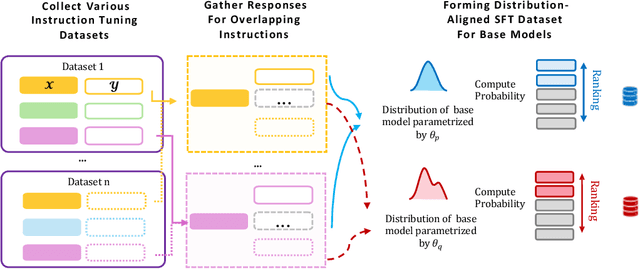
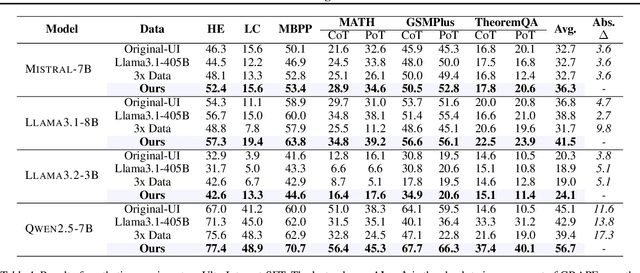
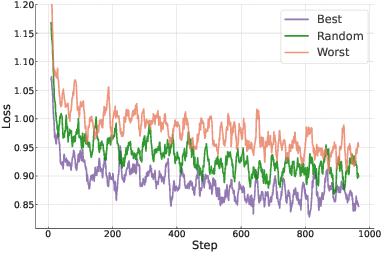
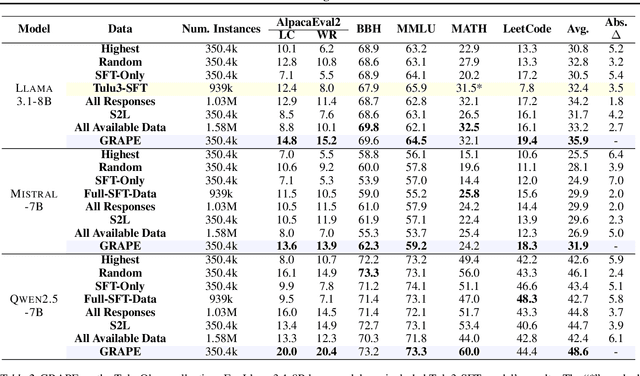
Abstract:High-quality supervised fine-tuning (SFT) data are crucial for eliciting strong capabilities from pretrained large language models (LLMs). Typically, instructions are paired with multiple responses sampled from other LLMs, which are often out of the distribution of the target model to be fine-tuned. This, at scale, can lead to diminishing returns and even hurt the models' performance and robustness. We propose **GRAPE**, a novel SFT framework that accounts for the unique characteristics of the target model. For each instruction, it gathers responses from various LLMs and selects the one with the highest probability measured by the target model, indicating that it aligns most closely with the target model's pretrained distribution; it then proceeds with standard SFT training. We first evaluate GRAPE with a controlled experiment, where we sample various solutions for each question in UltraInteract from multiple models and fine-tune commonly used LMs like LLaMA3.1-8B, Mistral-7B, and Qwen2.5-7B on GRAPE-selected data. GRAPE significantly outperforms strong baselines, including distilling from the strongest model with an absolute gain of up to 13.8%, averaged across benchmarks, and training on 3x more data with a maximum performance improvement of 17.3%. GRAPE's strong performance generalizes to realistic settings. We experiment with the post-training data used for Tulu3 and Olmo-2. GRAPE outperforms strong baselines trained on 4.5 times more data by 6.1% and a state-of-the-art data selection approach by 3% on average performance. Remarkably, using 1/3 of the data and half the number of epochs, GRAPE enables LLaMA3.1-8B to surpass the performance of Tulu3-SFT by 3.5%.
Improving Influence-based Instruction Tuning Data Selection for Balanced Learning of Diverse Capabilities
Jan 21, 2025
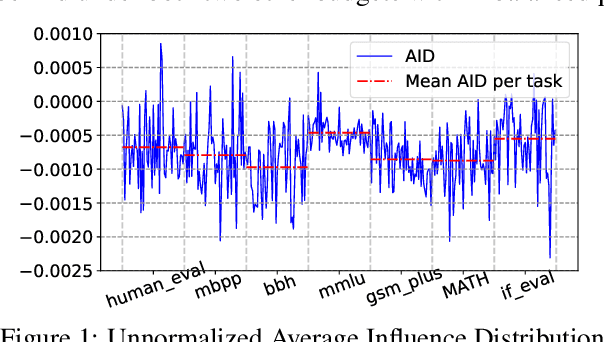
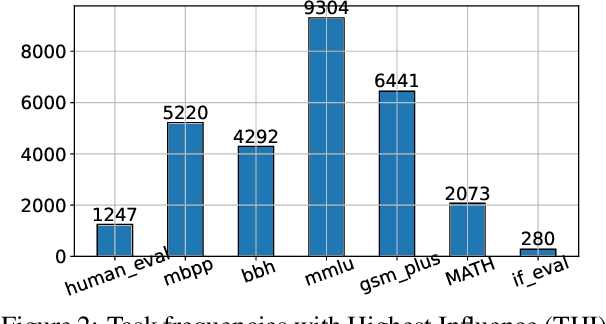
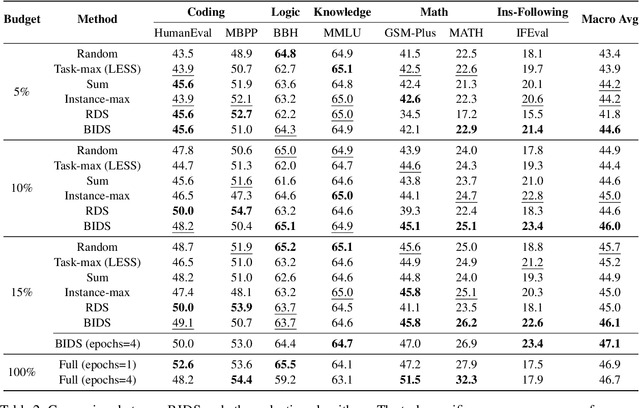
Abstract:Selecting appropriate training data is crucial for effective instruction fine-tuning of large language models (LLMs), which aims to (1) elicit strong capabilities, and (2) achieve balanced performance across a diverse range of tasks. Influence-based methods show promise in achieving (1) by estimating the contribution of each training example to the model's predictions, but often struggle with (2). Our systematic investigation reveals that this underperformance can be attributed to an inherent bias where certain tasks intrinsically have greater influence than others. As a result, data selection is often biased towards these tasks, not only hurting the model's performance on others but also, counterintuitively, harms performance on these high-influence tasks themselves. As a remedy, we propose BIDS, a Balanced and Influential Data Selection algorithm. BIDS first normalizes influence scores of the training data, and then iteratively balances data selection by choosing the training example with the highest influence on the most underrepresented task. Experiments with both Llama-3 and Mistral-v0.3 on seven benchmarks spanning five diverse capabilities show that BIDS consistently outperforms both state-of-the-art influence-based algorithms and other non-influence-based selection frameworks. Surprisingly, training on a 15% subset selected by BIDS can even outperform full-dataset training with a much more balanced performance. Our analysis further highlights the importance of both instance-level normalization and iterative optimization of selected data for balanced learning of diverse capabilities.
Entropy-Regularized Process Reward Model
Dec 15, 2024Abstract:Large language models (LLMs) have shown promise in performing complex multi-step reasoning, yet they continue to struggle with mathematical reasoning, often making systematic errors. A promising solution is reinforcement learning (RL) guided by reward models, particularly those focusing on process rewards, which score each intermediate step rather than solely evaluating the final outcome. This approach is more effective at guiding policy models towards correct reasoning trajectories. In this work, we propose an entropy-regularized process reward model (ER-PRM) that integrates KL-regularized Markov Decision Processes (MDP) to balance policy optimization with the need to prevent the policy from shifting too far from its initial distribution. We derive a novel reward construction method based on the theoretical results. Our theoretical analysis shows that we could derive the optimal reward model from the initial policy sampling. Our empirical experiments on the MATH and GSM8K benchmarks demonstrate that ER-PRM consistently outperforms existing process reward models, achieving 1% improvement on GSM8K and 2-3% improvement on MATH under best-of-N evaluation, and more than 1% improvement under RLHF. These results highlight the efficacy of entropy-regularization in enhancing LLMs' reasoning capabilities.
$\textbf{Only-IF}$:Revealing the Decisive Effect of Instruction Diversity on Generalization
Oct 07, 2024Abstract:Understanding and accurately following instructions is critical for large language models (LLMs) to be effective across diverse tasks. In this work, we rigorously examine the key factors that enable models to generalize to unseen instructions, providing insights to guide the collection of data for instruction-tuning. Through controlled experiments, inspired by the Turing-complete Markov algorithm, we demonstrate that such generalization $\textbf{only emerges}$ when training data is diversified enough across semantic domains. Our findings also reveal that merely diversifying within limited domains fails to ensure robust generalization. In contrast, cross-domain data diversification, even under constrained data budgets, significantly enhances a model's adaptability. We further extend our analysis to real-world scenarios, including fine-tuning of $\textit{$\textbf{specialist}$}$ and $\textit{$\textbf{generalist}$}$ models. In both cases, we demonstrate that 1) better performance can be achieved by increasing the diversity of an established dataset while keeping the data size constant, and 2) when scaling up the data, diversifying the semantics of instructions is more effective than simply increasing the quantity of similar data. Our research provides important insights for dataset collation, particularly when optimizing model performance by expanding training data for both specialist and generalist scenarios. We show that careful consideration of data diversification is key: training specialist models with data extending beyond their core domain leads to significant performance improvements, while generalist models benefit from diverse data mixtures that enhance their overall instruction-following capabilities across a wide range of applications. Our results highlight the critical role of strategic diversification and offer clear guidelines for improving data quality.
Visual Prompting in LLMs for Enhancing Emotion Recognition
Oct 03, 2024Abstract:Vision Large Language Models (VLLMs) are transforming the intersection of computer vision and natural language processing. Nonetheless, the potential of using visual prompts for emotion recognition in these models remains largely unexplored and untapped. Traditional methods in VLLMs struggle with spatial localization and often discard valuable global context. To address this problem, we propose a Set-of-Vision prompting (SoV) approach that enhances zero-shot emotion recognition by using spatial information, such as bounding boxes and facial landmarks, to mark targets precisely. SoV improves accuracy in face count and emotion categorization while preserving the enriched image context. Through a battery of experimentation and analysis of recent commercial or open-source VLLMs, we evaluate the SoV model's ability to comprehend facial expressions in natural environments. Our findings demonstrate the effectiveness of integrating spatial visual prompts into VLLMs for improving emotion recognition performance.
QEDCartographer: Automating Formal Verification Using Reward-Free Reinforcement Learning
Aug 17, 2024



Abstract:Formal verification is a promising method for producing reliable software, but the difficulty of manually writing verification proofs severely limits its utility in practice. Recent methods have automated some proof synthesis by guiding a search through the proof space using a theorem prover. Unfortunately, the theorem prover provides only the crudest estimate of progress, resulting in effectively undirected search. To address this problem, we create QEDCartographer, an automated proof-synthesis tool that combines supervised and reinforcement learning to more effectively explore the proof space. QEDCartographer incorporates the proofs' branching structure, enabling reward-free search and overcoming the sparse reward problem inherent to formal verification. We evaluate QEDCartographer using the CoqGym benchmark of 68.5K theorems from 124 open-source Coq projects. QEDCartographer fully automatically proves 21.4% of the test-set theorems. Previous search-based proof-synthesis tools Tok, Tac, ASTactic, Passport, and Proverbot9001, which rely only on supervised learning, prove 9.6%, 9.8%, 10.9%, 12.5%, and 19.8%, respectively. Diva, which combines 62 tools, proves 19.2%. Comparing to the most effective prior tool, Proverbot9001, QEDCartographer produces 26% shorter proofs 27% faster, on average over the theorems both tools prove. Together, QEDCartographer and non-learning-based CoqHammer prove 31.8% of the theorems, while CoqHammer alone proves 26.6%. Our work demonstrates that reinforcement learning is a fruitful research direction for improving proof-synthesis tools' search mechanisms.
PLUM: Preference Learning Plus Test Cases Yields Better Code Language Models
Jun 11, 2024Abstract:Instruction-finetuned code language models (LMs) have shown promise in various programming tasks. They are trained, using a language modeling objective, on natural language instructions and gold code snippet pairs. Recent evidence suggests that these models, never exposed to incorrect solutions during training, often struggle to distinguish between correct and incorrect solutions. This observation raises our inquiry: Can preference learning, which trains models to prefer correct solutions over incorrect ones, help push the boundaries of code LMs even further? We propose PLUM, a novel \textbf{p}reference \textbf{l}earning framework a\textbf{u}gmented with test cases tailored for code L\textbf{M}s.PLUM aims to investigate the key success factors and potential benefits of preference learning in code LMs, which remain elusive despite its success in aligning LMs with human values. PLUM consists of three stages: (1) Generating test cases for natural language instructions, (2) sampling candidate solutions from the policy and evaluating them against the test cases to create a preference dataset, which is then used to (3) train the policy with a preference learning algorithm. Experiments demonstrate that PLUM substantially improves the performance of existing code LMs on established code generation benchmarks such as HumanEval (+) and MBPP (+), even for the state-of-the-art open-source language model CodeQwen-1.5-7B-Chat. PLUM complements the supervised fine-tuning (SFT) stage, demonstrating synergistic effects.
From Symbolic Tasks to Code Generation: Diversification Yields Better Task Performers
May 31, 2024Abstract:Instruction tuning -- tuning large language models on instruction-output pairs -- is a promising technique for making models better adapted to the real world. Yet, the key factors driving the model's capability to understand and follow instructions not seen during training remain under-explored. Our investigation begins with a series of synthetic experiments within the theoretical framework of a Turing-complete algorithm called Markov algorithm, which allows fine-grained control over the instruction-tuning data. Generalization and robustness with respect to the training distribution emerge once a diverse enough set of tasks is provided, even though very few examples are provided for each task. We extend these initial results to a real-world application scenario of code generation and find that a more diverse instruction set, extending beyond code-related tasks, improves the performance of code generation. Our observations suggest that a more diverse semantic space for instruction-tuning sets greatly improves the model's ability to follow instructions and perform tasks.
Instruction Diversity Drives Generalization To Unseen Tasks
Feb 16, 2024
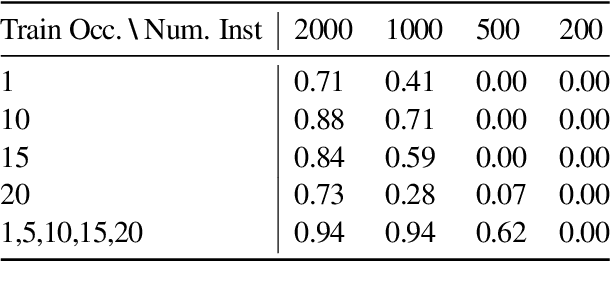
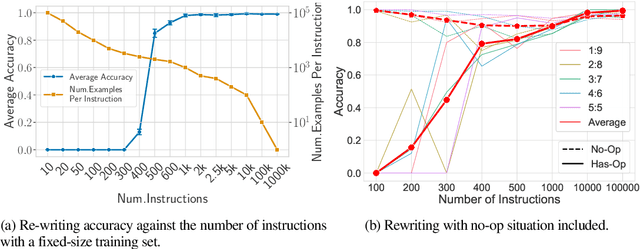
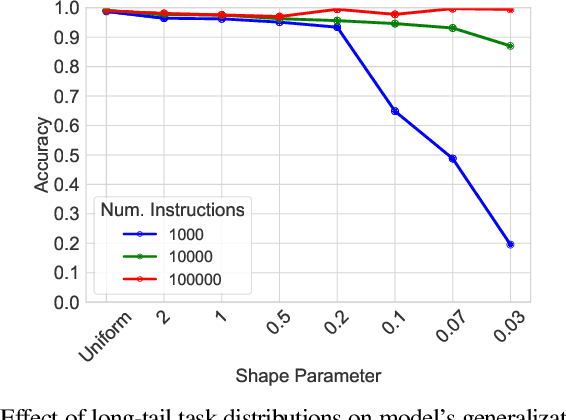
Abstract:Instruction tuning -- fine-tuning a large language model (LLM) on pairs of instructions and desired outcomes -- is an approach that enables pre-trained language models to perform real-world tasks and follow human instructions. Its practical success depends on the model learning a broader set of instructions than those it was trained on. Yet the factors that determine model generalization to such \emph{unseen tasks} are not well understood. %To understand the driving factors of generalization, In this paper, we experiment with string rewrites, a symbolic task that serves as a building block for Turing complete Markov algorithms while allowing experimental control of "inputs" and "instructions". We investigate the trade-off between the number of instructions the model is trained on and the number of training samples provided for each instruction and observe that the diversity of the instruction set determines generalization. Generalization emerges once a diverse enough set of tasks is provided, even though very few examples are provided for each task. Instruction diversity also ensures robustness with respect to non-uniform distributions of instructions in the training set.
 Add to Chrome
Add to Chrome Add to Firefox
Add to Firefox Add to Edge
Add to Edge